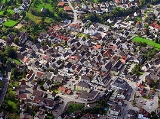
Balve
Encyclopedia
Balve is a town in the Märkischer Kreis
district, North Rhine-Westphalia
, Germany
. It is located in Hönnetal, a narrow valley created by the river Hönne
, which is near the Sorpe
see, formerly part of Balve, and at the north end of the Sauerland
, near Dortmund
. The town was established in 1975 with several divisions including Balve, Beckum, and Eisborn.
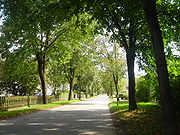 The first disputed reference to Balve was in around 780, when it was mentioned that a Widukind
The first disputed reference to Balve was in around 780, when it was mentioned that a Widukind
owned a farm called Ballowa, another name for the town. The first undisputed reference was in 864, in which a blind girl from Balve was said to be healed at the grave of the Saint Ludger
in the crypt of Werden Abbey
.
Ballowa is also mentioned in the Thidrekssaga, a chivalric saga written in the mid-13th century in Norway
. In the saga, Ballowa is the home of two dwarfs who taught Weyland
much about making iron weapons. At the time of writing, Balve belonged to the county of Arnsberg
.
In 1358 the town became the property of the Duchy of Westphalia
, which belonged to the Archbishops of Cologne
. In 1430 it was given the right to be called a city. During the Napoleonic period, it belonged for a short time (1802–1815) to Hesse
, after which time it became part of the Kingdom of Prussia
.
In 1975, during a local government reorganization, the city was enlarged by the addition of the several former independent municipalities from the abolished Amt Balve, including Asbeck, Beckum, and Eisborn.
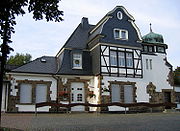 Local organizations include a Red Cross chapter, and the Schützenbruderschaft St. Sebastian Balve, founded in 1947. Primary schools in the town include Grundschule Balve and Grundschule Beckum. Several international companies have roots in the town, including Balver Zinn, Chemie Wocklum, and Kruse Group.
Local organizations include a Red Cross chapter, and the Schützenbruderschaft St. Sebastian Balve, founded in 1947. Primary schools in the town include Grundschule Balve and Grundschule Beckum. Several international companies have roots in the town, including Balver Zinn, Chemie Wocklum, and Kruse Group.
Train stations in Balve include Binolen, Volkringhausen, Sanssouci, Garbeck and Balve, the latter station part of the Hönnetalbahn (RB 54) line.
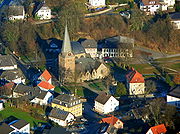 The main religion in Balve is Roman Catholicism. The church Saint Blaise
The main religion in Balve is Roman Catholicism. The church Saint Blaise
, built in the 12th century and an example of Romanesque architecture
, was consecrated to Mary
. On February 3 each year a special ceremony is held in the church, called the Blessing of the Throats
. The altar servers of Saint Blaise visit other cities every year, for example Georgsmarienhütte
in 1982. Bones from Benedict of Nursia
and Saint Blaise
, and a 400-year-old monument for Hermann von Hatzfeld, are located in the church. Additionally, two Roman Catholic parishes have been present in Balve for several years.
A Lutheran church is located at Hönnetalstrasse near to the Gemeindezentrum.
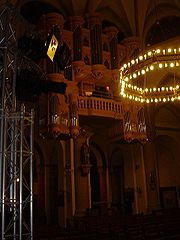 The Männerchor 1860 Balve is the largest choir in Balve. Other choirs include the Männerchor Garbeck and MC Cäcilia Volkringhausen. The town's bands include Musikverein Balve and Musikverein Garbeck.
The Männerchor 1860 Balve is the largest choir in Balve. Other choirs include the Männerchor Garbeck and MC Cäcilia Volkringhausen. The town's bands include Musikverein Balve and Musikverein Garbeck.
Until 2005, the organization Festpiele Balver Höhle and the town of Balve have jointly hosted a jazz
festival. Acts at the festival have included performances by Jan Garbarek
and by Piirpauke. One of the theatre ensembles in Balve is the Kolpingtheatergruppe, directed by Christoph Rapp. Another form of entertainment, the Balver Märchenwochen, involves performing fairy tales at Christsmas.
, a cave in Balve. The festival is a major focus of the culture in and around the town, featuring music and theatre performances. The only marksmen's festival, Schützenfest
, is also held in a cave, and is organized by Schützenbruderschaft St. Sebastian.
A large bonfire on Easter Sunday is another tradition in Balve, organized by the Kolpingsfamilie Balve. On May 1 each year the fire brigade of Balve is invited to the Feuerwehrfest, and for 20 years a christmas market
has organized by Balver Fachhandel that features a live nativity scene.
, a competition between horse riders.
Participiants in the Balve Optimum have included:
Horse jumping
Dressage
 There are many caves in the Hönnetal, including the Balver Höhle
There are many caves in the Hönnetal, including the Balver Höhle
at Helle, a large cave used for cultural events such as concerts, stage acting and the annual marksmen's festival, and the Reckenhöhle, a cave 1,478 ft in length that has flowstone
. Experts have found signs of cannibalism
in some of the caves.
Other points of interest include
, and the black-and-white cross from that of Cologne
. Both symbols were present in old seals of the city, of which the oldest known example dates from 1462. The coat of arms was officially granted on June 24, 1911, and confirmed on February 6, 1976, after the local government reorganization of 1975.
The bottom part of the coat of arms of the former Amt Balve is identical Bolve's town arms. The top half showed St. Peter, wearing a red coat and holding in his left hand a golden key and in his right a golden book. This coat of arms was granted on March 5, 1957, and expired when the Amt was dissolved in 1975.
Märkischer Kreis
The Märkischer Kreis is a district in central North Rhine-Westphalia, Germany. Neighbouring districts are Unna, Soest, Hochsauerland, Olpe, Oberbergischer Kreis, Ennepe-Ruhr, and the city of Hagen.-History:...
district, North Rhine-Westphalia
North Rhine-Westphalia
North Rhine-Westphalia is the most populous state of Germany, with four of the country's ten largest cities. The state was formed in 1946 as a merger of the northern Rhineland and Westphalia, both formerly part of Prussia. Its capital is Düsseldorf. The state is currently run by a coalition of the...
, Germany
Germany
Germany , officially the Federal Republic of Germany , is a federal parliamentary republic in Europe. The country consists of 16 states while the capital and largest city is Berlin. Germany covers an area of 357,021 km2 and has a largely temperate seasonal climate...
. It is located in Hönnetal, a narrow valley created by the river Hönne
Hönne
The Hönne is a left tributary river to the Ruhr, flowing through the northern Sauerland hills in North Rhine-Westphalia, Germany. The spring of the Hönne is located in the west of Neuenrade at 437m above sea level. After 33 km the river ends near the town of Fröndenberg...
, which is near the Sorpe
Sorpe
The Sorpe Dam is a dam near the small town of Sundern in the German district of Hochsauerland in North Rhine-Westphalia.Like the Biggesee, the Möhne Reservoir and the Verse reservoir, the Sorpe's reservoir is one of the major artificial lakes of the Sauerland's Ruhrverband reservoir association...
see, formerly part of Balve, and at the north end of the Sauerland
Sauerland
The Sauerland is a rural, hilly area spreading across most of the south-eastern part of North Rhine-Westphalia, in parts heavily forested and, apart from the major valleys, sparsely inhabited...
, near Dortmund
Dortmund
Dortmund is a city in Germany. It is located in the Bundesland of North Rhine-Westphalia, in the Ruhr area. Its population of 585,045 makes it the 7th largest city in Germany and the 34th largest in the European Union....
. The town was established in 1975 with several divisions including Balve, Beckum, and Eisborn.
History

Widukind
Widukind was a pagan Saxon leader and the chief opponent of Charlemagne during the Saxon Wars. Widukind was the leader of the Saxons against the Frankish king Charlemagne...
owned a farm called Ballowa, another name for the town. The first undisputed reference was in 864, in which a blind girl from Balve was said to be healed at the grave of the Saint Ludger
Ludger
Saint Ludger was a missionary among the Frisians and Saxons, founder of Werden Abbey and first Bishop of Münster in Westphalia....
in the crypt of Werden Abbey
Werden Abbey
Werden Abbey was a Benedictine monastery in Essen-Werden , situated on the Ruhr.- The foundation of the abbey :Near Essen Saint Ludger founded a monastery in 799 and became its first abbot. The little church which Saint Ludger built here in honor of Saint Stephen was completed in 804 and dedicated...
.
Ballowa is also mentioned in the Thidrekssaga, a chivalric saga written in the mid-13th century in Norway
Norway
Norway , officially the Kingdom of Norway, is a Nordic unitary constitutional monarchy whose territory comprises the western portion of the Scandinavian Peninsula, Jan Mayen, and the Arctic archipelago of Svalbard and Bouvet Island. Norway has a total area of and a population of about 4.9 million...
. In the saga, Ballowa is the home of two dwarfs who taught Weyland
Weyland
In Germanic and Norse mythology, Wayland the Smith is a legendary master blacksmith. In Old Norse sources, Völundr appears in Völundarkviða, a poem in the Poetic Edda, and in Þiðrekssaga, and his legend is also depicted on the Ardre image stone VIII...
much about making iron weapons. At the time of writing, Balve belonged to the county of Arnsberg
Arnsberg
Arnsberg is a town in the Hochsauerland district, in North Rhine-Westphalia, Germany. It is the location of the Regierungsbezirk Arnsberg's administration and one of the three local administration offices of the Hochsauerlandkreis.-Geography:...
.
In 1358 the town became the property of the Duchy of Westphalia
Westphalia
Westphalia is a region in Germany, centred on the cities of Arnsberg, Bielefeld, Dortmund, Minden and Münster.Westphalia is roughly the region between the rivers Rhine and Weser, located north and south of the Ruhr River. No exact definition of borders can be given, because the name "Westphalia"...
, which belonged to the Archbishops of Cologne
Archbishopric of Cologne
The Electorate of Cologne was an ecclesiastical principality of the Holy Roman Empire and existed from the 10th to the early 19th century. It consisted of the temporal possessions of the Roman Catholic Archdiocese of Cologne . It was ruled by the Archbishop in his function as prince-elector of...
. In 1430 it was given the right to be called a city. During the Napoleonic period, it belonged for a short time (1802–1815) to Hesse
Hesse
Hesse or Hessia is both a cultural region of Germany and the name of an individual German state.* The cultural region of Hesse includes both the State of Hesse and the area known as Rhenish Hesse in the neighbouring Rhineland-Palatinate state...
, after which time it became part of the Kingdom of Prussia
Kingdom of Prussia
The Kingdom of Prussia was a German kingdom from 1701 to 1918. Until the defeat of Germany in World War I, it comprised almost two-thirds of the area of the German Empire...
.
In 1975, during a local government reorganization, the city was enlarged by the addition of the several former independent municipalities from the abolished Amt Balve, including Asbeck, Beckum, and Eisborn.
Organizations, economy and transportation

Train stations in Balve include Binolen, Volkringhausen, Sanssouci, Garbeck and Balve, the latter station part of the Hönnetalbahn (RB 54) line.
Religion

Saint Blaise
Saint Blaise was a physician, and bishop of Sebastea . According to his Acta Sanctorum, he was martyred by being beaten, attacked with iron carding combs, and beheaded...
, built in the 12th century and an example of Romanesque architecture
Romanesque architecture
Romanesque architecture is an architectural style of Medieval Europe characterised by semi-circular arches. There is no consensus for the beginning date of the Romanesque architecture, with proposals ranging from the 6th to the 10th century. It developed in the 12th century into the Gothic style,...
, was consecrated to Mary
Mary (mother of Jesus)
Mary , commonly referred to as "Saint Mary", "Mother Mary", the "Virgin Mary", the "Blessed Virgin Mary", or "Mary, Mother of God", was a Jewish woman of Nazareth in Galilee...
. On February 3 each year a special ceremony is held in the church, called the Blessing of the Throats
Blessing of the Throats
The Blessing of the Throats is a ritual prescribed and authorized by the Roman Catholic Church, usually observed on the feast day of Saint Blaise...
. The altar servers of Saint Blaise visit other cities every year, for example Georgsmarienhütte
Georgsmarienhütte
Georgsmarienhütte is a town in the district of Osnabrück, in Lower Saxony, Germany. It is situated in the Teutoburg Forest, approx. 7 km south of Osnabrück.- History :...
in 1982. Bones from Benedict of Nursia
Benedict of Nursia
Saint Benedict of Nursia is a Christian saint, honored by the Roman Catholic Church as the patron saint of Europe and students.Benedict founded twelve communities for monks at Subiaco, about to the east of Rome, before moving to Monte Cassino in the mountains of southern Italy. There is no...
and Saint Blaise
Saint Blaise
Saint Blaise was a physician, and bishop of Sebastea . According to his Acta Sanctorum, he was martyred by being beaten, attacked with iron carding combs, and beheaded...
, and a 400-year-old monument for Hermann von Hatzfeld, are located in the church. Additionally, two Roman Catholic parishes have been present in Balve for several years.
A Lutheran church is located at Hönnetalstrasse near to the Gemeindezentrum.
Performing arts

Until 2005, the organization Festpiele Balver Höhle and the town of Balve have jointly hosted a jazz
Jazz
Jazz is a musical style that originated at the beginning of the 20th century in African American communities in the Southern United States. It was born out of a mix of African and European music traditions. From its early development until the present, jazz has incorporated music from 19th and 20th...
festival. Acts at the festival have included performances by Jan Garbarek
Jan Garbarek
Jan Garbarek is a Norwegian tenor and soprano saxophonist, active in the jazz, classical, and world music genres. Garbarek was born in Mysen, Norway, the only child of a former Polish prisoner of war Czesław Garbarek and a Norwegian farmer's daughter...
and by Piirpauke. One of the theatre ensembles in Balve is the Kolpingtheatergruppe, directed by Christoph Rapp. Another form of entertainment, the Balver Märchenwochen, involves performing fairy tales at Christsmas.
Festivals
The Festspiele Balver Höhle is held at the Balver HöhleBalver Höhle
The Balve Cave is the biggest cultural cave in Europe. It is located in Balve, Germany.-History:The Balve Cave was mentioned in the Thidrekssaga. Since 160 years the annual Schützenfest is a part of the culture. In 1985 the Festspiele Balver Höhle were founded with the mystery play Katharina von...
, a cave in Balve. The festival is a major focus of the culture in and around the town, featuring music and theatre performances. The only marksmen's festival, Schützenfest
Schützenfest
A Schützenfest is a traditional festival or fair featuring a target shooting competition in the cultures of both Germany and Switzerland....
, is also held in a cave, and is organized by Schützenbruderschaft St. Sebastian.
A large bonfire on Easter Sunday is another tradition in Balve, organized by the Kolpingsfamilie Balve. On May 1 each year the fire brigade of Balve is invited to the Feuerwehrfest, and for 20 years a christmas market
Christmas Market
A Christmas market, also known as Christkindlmarkt, Christkindlesmarkt, Christkindlmarket, and Weihnachtsmarkt, is a street market associated with the celebration of Christmas during the four weeks of Advent...
has organized by Balver Fachhandel that features a live nativity scene.
Sports
One of the soccer clubs in Balve, SG Balve/Garbeck, won the DFB-Ü 40-Cup in 2007. The town also organizes the Balve OptimumBalve Optimum
The Balve Optimum is a tournament between horse riders in Balve. It is placed at Balve Wocklum, the home of Dieter von Landsberg-Velen...
, a competition between horse riders.
Participiants in the Balve Optimum have included:
Horse jumping
- Reiner KlimkeReiner KlimkeDr Reiner Klimke was a German equestrian, who won six gold and two bronze medals in dressage at the Summer Olympics — a record for equestrian events...
- Paul SchockemöhlePaul SchockemöhlePaul Schockemöhle is a former German showjumper. He is the brother of Alwin Schockemöhle, another leading German rider.He was three times European Champion on his best horse Deister....
- Ludger BeerbaumLudger BeerbaumLudger Beerbaum is an internationally successful German rider who competes in show jumping, and has been ranked the No. 1 Show Jumper in the world by the FEI on multiple occasions....
- Markus Beerbaum
- Jessica KürtenJessica KürtenJessica Kürten is an Irish equestrian who competes in the sport of show jumping.Born Jessica Chesney, Kürten won several national pony championships as a youth....
(2007) - Hugo SimonHugo SimonHugo Simon, born 3 August 1942 in Křivá Voda near Šumperk, present-day Czech Republic, is an Olympic medal-winning Austrian show jumper who competed at six Olympics between 1972 and 1996 ....
(2008) - Meredith Michaels-BeerbaumMeredith Michaels-BeerbaumMeredith Michaels-Beerbaum is an American-born German equestrian who competes at the international level in show jumping....
(2008) - Eva Bitter (2008)
Dressage
- Isabell WerthIsabell WerthIsebell Werth is a German equestrian and world champion in dressage.-Championships:...
(2008) - Matthias Alexander Rath (2008)
Points of interest

Balver Höhle
The Balve Cave is the biggest cultural cave in Europe. It is located in Balve, Germany.-History:The Balve Cave was mentioned in the Thidrekssaga. Since 160 years the annual Schützenfest is a part of the culture. In 1985 the Festspiele Balver Höhle were founded with the mystery play Katharina von...
at Helle, a large cave used for cultural events such as concerts, stage acting and the annual marksmen's festival, and the Reckenhöhle, a cave 1,478 ft in length that has flowstone
Flowstone
Flowstones are composed of sheetlike deposits of calcite formed where water flows down the walls or along the floors of a cave. They are typically found in "solution", or limestone caves, where they are the most common speleothem. However, they may form in any type of cave where water enters that...
. Experts have found signs of cannibalism
Cannibalism
Cannibalism is the act or practice of humans eating the flesh of other human beings. It is also called anthropophagy...
in some of the caves.
Other points of interest include
- The walls of an old Germanic farm, located Garbeck,
- BeckumBeckumBeckum may refer to:* Beckum, Germany, a town in Germany* Beckum, Overijssel, a town in the Netherlands...
, where scientists found bones from eight kind of species of dinosaurDinosaurDinosaurs are a diverse group of animals of the clade and superorder Dinosauria. They were the dominant terrestrial vertebrates for over 160 million years, from the late Triassic period until the end of the Cretaceous , when the Cretaceous–Paleogene extinction event led to the extinction of...
s from the cretaceousCretaceousThe Cretaceous , derived from the Latin "creta" , usually abbreviated K for its German translation Kreide , is a geologic period and system from circa to million years ago. In the geologic timescale, the Cretaceous follows the Jurassic period and is followed by the Paleogene period of the...
, and - The Luisenhütte, the only surviging 18th-century blast furnaceBlast furnaceA blast furnace is a type of metallurgical furnace used for smelting to produce industrial metals, generally iron.In a blast furnace, fuel and ore and flux are continuously supplied through the top of the furnace, while air is blown into the bottom of the chamber, so that the chemical reactions...
that is still in workable condition, situated close to the 14th-century castle Schloss Wocklum, the home of Count Dieter von Landsberg-Velen.
Coat of arms
The town's coat of arms references the history of Balve. The eagle is taken from the arms of ArnsbergArnsberg
Arnsberg is a town in the Hochsauerland district, in North Rhine-Westphalia, Germany. It is the location of the Regierungsbezirk Arnsberg's administration and one of the three local administration offices of the Hochsauerlandkreis.-Geography:...
, and the black-and-white cross from that of Cologne
Cologne
Cologne is Germany's fourth-largest city , and is the largest city both in the Germany Federal State of North Rhine-Westphalia and within the Rhine-Ruhr Metropolitan Area, one of the major European metropolitan areas with more than ten million inhabitants.Cologne is located on both sides of the...
. Both symbols were present in old seals of the city, of which the oldest known example dates from 1462. The coat of arms was officially granted on June 24, 1911, and confirmed on February 6, 1976, after the local government reorganization of 1975.
The bottom part of the coat of arms of the former Amt Balve is identical Bolve's town arms. The top half showed St. Peter, wearing a red coat and holding in his left hand a golden key and in his right a golden book. This coat of arms was granted on March 5, 1957, and expired when the Amt was dissolved in 1975.
Persons of interest
- Franz HoffmeisterFranz HoffmeisterFranz Hoffmeister was a Roman Catholic priest and the founder of the Sauerländer Heimatbund and Festspiele Balver Höhle.-Vita:He was consecrated to a Roman Catholic priest by bishop Hähling von Lanzenauer in 1924....
(† 1943), Roman Catholic priest - Theodor PröpperTheodor PröpperTheodor Pröpper was a German church organist and composer. Pröpper was born in Balve and spent most of his career there as an organist at Saint Blasius church.-Career:...
(† 1979), composer - Hermann WedekindHermann WedekindHermann Wedekind was an artistic director at Festspiele Balver Höhle in the years 1985 - 1996.-Vita:Formerly he was a theatre director in Saarbrücken where he met Oskar Lafontaine...
(† 1998), actor, operasinger and theatredirector

